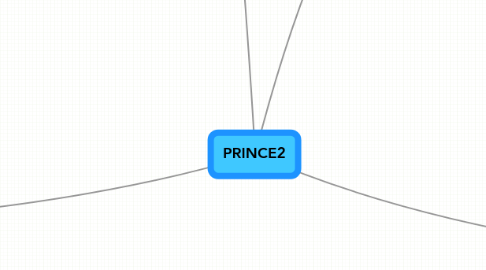
1. Principles
1.1. Continued Business Justification
1.1.1. At the start
1.1.2. continuous through the project
1.1.3. end justifies the means
1.1.4. specific objective
1.1.4.1. one product
1.1.5. Alignment to corporate strategy
1.2. Learn from experience
1.3. Defined Roles & responsibilities
1.4. Manage by Stages
1.4.1. Reasons
1.4.1.1. decision makers involved at appropriate intervals
1.4.1.2. 1 stage at a time
1.4.1.3. too short = unnecessary management effort
1.4.1.4. too long = not enough management involvement
1.4.2. project viability checked at end of each stage
1.5. Manage by exception
1.5.1. Defined tolerances
1.5.1.1. Time
1.5.1.2. Cost
1.5.1.3. Quality
1.5.1.4. Scope
1.5.1.5. Risk
1.5.1.6. Benefit
1.5.2. establish limits of delegated authority
1.6. Focus on Products
1.6.1. Product oriented
1.6.2. not activity oriented
1.6.3. What is a product
1.6.3.1. input or output
1.6.3.2. tangible or intangible
1.6.3.3. can be described in advance
1.6.3.4. can be created
1.6.3.5. can be tested
1.7. Tailor to suit the project environment
1.7.1. PRINCE2 a flexible process
1.7.2. Board and PM decide how method will be applied
2. Themes
2.1. Business Case
2.1.1. vital test of viability
2.1.2. dynamic - can change over time
2.1.3. proj must have continued biz justification
2.1.4. Approach
2.1.4.1. Develop
2.1.4.1.1. by Pr Executive
2.1.4.2. Verify
2.1.4.2.1. Pr board responsible
2.1.4.2.2. component of the PID
2.1.4.3. Maintain
2.1.4.3.1. Done at Managing Stage Boundary process
2.1.4.4. Confirm
2.1.4.4.1. via realisations of benefits
2.1.4.4.2. objective measures
2.1.5. 9 Sections
2.1.5.1. Management Overview
2.1.5.2. Reasons
2.1.5.3. Business Options
2.1.5.3.1. Do nothing?
2.1.5.3.2. Do the minimum?
2.1.5.3.3. Do something?
2.1.5.3.4. Do the utmost?
2.1.5.4. Expected benefits
2.1.5.5. Expected dis-benefits
2.1.5.6. Timescales
2.1.5.7. Costs
2.1.5.8. Investment Appraisal
2.1.5.9. Major Risks
2.2. Organisation
2.2.1. 4 Layers
2.2.1.1. Corporate or Prog Management - commissioning
2.2.1.2. Project Board - Directing
2.2.1.2.1. Membership
2.2.1.2.2. Responsibilities
2.2.1.3. Pr Manager - Managing
2.2.1.3.1. primary focus of PRINCE2
2.2.1.3.2. from customer organisation
2.2.1.3.3. delivers on behalf of board
2.2.1.3.4. NOT a joint role
2.2.1.4. Team Manager - Delivering
2.2.2. 3 interests
2.2.2.1. Business
2.2.2.1.1. does pr meet a business need?
2.2.2.1.2. will it provide value for money?
2.2.2.1.3. Looked after by Executive
2.2.2.2. User
2.2.2.2.1. those affected by the change
2.2.2.2.2. have to live with consequences
2.2.2.3. Supplier
2.3. Quality
2.3.1. What is quality?
2.3.1.1. Meeting acceptance criteria
2.3.1.2. "Fit for purpose" or "compliance with criteria"
2.3.1.3. FOCUS ON PRODUCTS!
2.3.2. Approach
2.3.2.1. Project Product Description
2.3.2.2. Quality management strategy
2.3.2.3. Product descriptions
2.3.2.3.1. NOT optional
2.3.2.3.2. Governs development of prod and review/approval
2.3.2.4. Quality Register
2.3.2.4.1. record details of planned and actual quality checks
2.3.2.5. Quality Review
2.3.2.5.1. tests prod conformance
2.3.2.5.2. works well for products with a large amount of subjectivity in their criteria
2.3.2.5.3. Good for reports, training manuals etc
2.4. Plans
2.5. Risk
2.6. Change
2.7. Progress
3. Processes
3.1. Starting up a project
3.1.1. Appoint Exec and PM
3.1.2. Capture previous lessons
3.1.3. Desibn & appoint PM team
3.1.4. Prepare outline Biz Case
3.1.5. Select pr approach and assemble pr brief
3.1.6. Plan initiation stage
3.2. Directing a project
3.2.1. Authorise initiation
3.2.2. Authorize the project
3.2.3. Authorise a stage or exception plan
3.2.4. Give ad hoc direction
3.2.5. Authorise project closure
3.3. Initiating a project
3.3.1. Main output is the PID
3.3.2. Activities
3.3.2.1. Prepare risk management strategy
3.3.2.2. Prepare configuration management strategy
3.3.2.3. Prepare quality mangement strategy
3.3.2.4. Prepare communications management strategy
3.3.2.5. Set up project controls
3.3.2.6. Create project plan
3.3.2.7. Refine business case
3.3.2.8. Assemble PID
3.3.2.8.1. contract between board and PM
3.4. Controlling a project
3.4.1. Day to day activities of the PM
3.4.2. activities
3.4.2.1. Auth a WP
3.4.2.2. Review WP status
3.4.2.3. Review completed WP
3.4.2.4. Review stage status
3.4.2.5. Report highlights
3.4.2.6. Capture and examine issues and risks
3.4.2.7. Take corrective action
3.4.2.8. Escalate issues and risks (to the board)
3.5. Managing project delivery
3.5.1. Undertaken by team managers
3.5.2. activities
3.5.2.1. Accept a WP
3.5.2.2. Execute a WP
3.5.2.3. Deliver a WP
3.6. Managing a stage boundary
3.6.1. enables board to authorize next stage
3.6.2. activities
3.6.2.1. Plan next stage
3.6.2.2. update project plan
3.6.2.3. update business case
3.6.2.4. report stage end
3.6.2.5. produce and exception plan
3.7. Closing a project
3.7.1. natural or premature
3.7.2. activities
3.7.2.1. prepare planned closure
3.7.2.2. prepare premature closure
3.7.2.3. hand over products
3.7.2.4. evaluate the project
3.7.2.5. recommend project closure
4. Basics
4.1. What is a project
4.1.1. Unique
4.1.2. bring about change
4.1.3. predefined product
4.1.4. temporary
4.1.5. cross-functional
4.1.6. uncertainty
4.2. vs Business as Usual
4.2.1. continuous
4.2.2. maintains existing operations
4.2.3. reactive
4.2.4. takes top priority
4.2.5. tried & tested
4.2.6. doing things the same way
4.3. Where do projects come from?
4.3.1. PEST
4.3.1.1. Political
4.3.1.2. Economic
4.3.1.3. Social
4.3.1.4. Technological
4.3.1.5. (Environmental)
4.3.1.6. (Legal)
